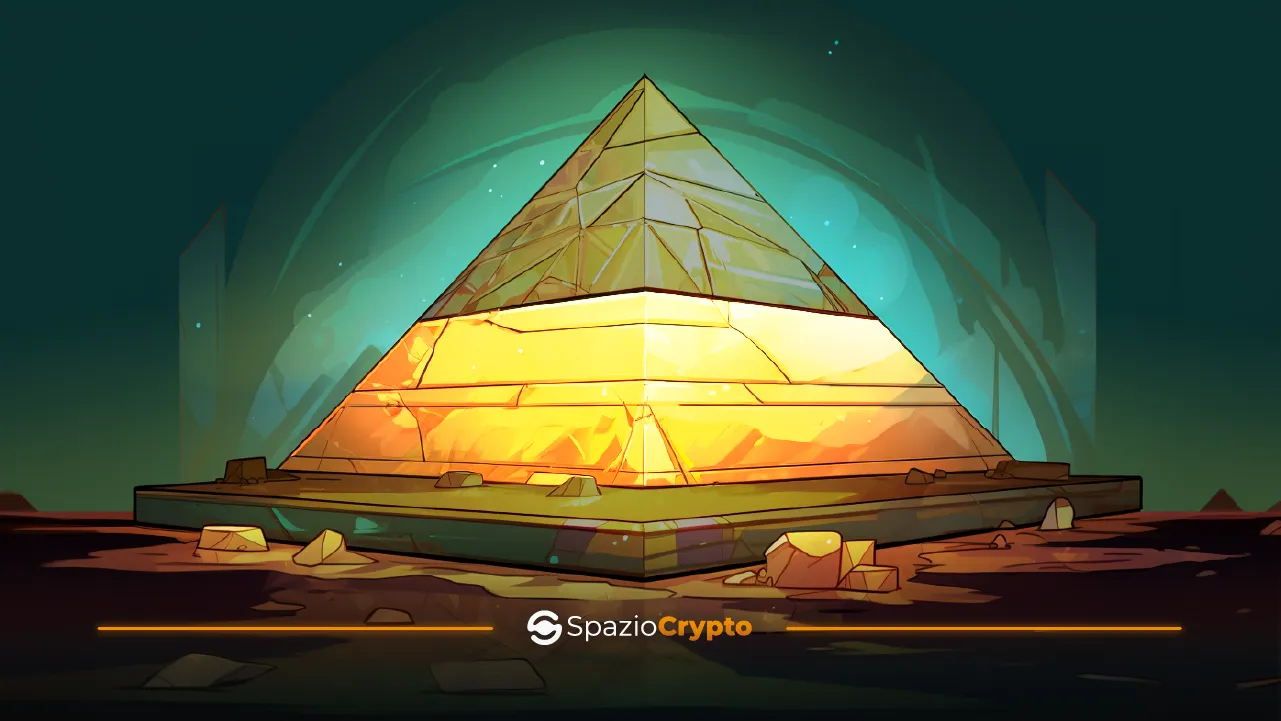The immutability and transparency of blockchain have opened the door to a wide range of applications, from DeFi (Decentralised Finance) to digital identity management. However, despite its many advantages, blockchain technology still faces significant challenges, including scalability and high operational costs.
In response to these challenges, 'Layer 2s', a set of protocols and technologies designed to improve the performance and efficiency of existing blockchains, have emerged. Layer 2s operate on top of the basic blockchain protocols, offering innovative solutions to improve scalability and reduce transaction costs.
In this Web3 guide from Spaziocrypto, we will explore in detail how Layer 2s work in the blockchain, examining their underlying technologies and their impact on overall system performance.
What is a Layer 2 in the Blockchain?
A Layer 2 represents an innovative solution designed to address the scalability and cost challenges associated with blockchains. Rather than directly modifying the underlying blockchain protocol, Layer 2s add an additional layer of complexity and functionality on top of the existing blockchain, offering creative solutions to improve system performance and efficiency.
Layer 2 structure
Layer 2s come in the form of a wide range of technologies and protocols, each offering a unique approach to addressing scalability and transaction speed challenges. Let's look in more detail at some of the most common technologies used in Layer 2:
- Lightning Networks: The lightning networks are a technique that allows users to conduct direct transactions with each other outside of the main blockchain. This method avoids the registration of each individual transaction on the main blockchain, thus reducing the workload on the network and increasing the overall scalability of the system. Lightning networks can be used for a wide range of applications, from micro-payments to high-frequency transaction management.
- Sidechains: Sidechains are separate blockchains that operate in parallel with the main blockchain. They allow users to perform faster and cheaper transactions, as the workload is distributed over a separate network. Sidechains can be connected to the main blockchain via security mechanisms such as the 'federation model' or via decentralised bridges. This approach offers flexibility and scalability, allowing different use cases to be managed in dedicated blockchain environments.
- Rollups: Rollups are protocols that compress and consolidate a large number of transactions before sending them to the main blockchain. This approach significantly reduces the workload on the main network, allowing for increased scalability without compromising security or decentralisation. Rollups can be categorised into on-chain (on-chain) and off-chain (off-chain) rollups, depending on where most of the transaction processing takes place.
Advantages of Layers 2
Layers 2 offer a number of significant advantages over traditional solutions based solely on the core blockchain:
- Scalability: They enable greater transaction scalability, allowing the blockchain to handle far more transactions than the core protocol. This is especially important in scenarios with high transaction frequency or high user volumes.
- Speed
- : Reduce transaction confirmation times and improve overall system efficiency. Users benefit from faster transactions and reduced waiting times, improving the overall user experience.
- Cost Reduction: They enable cheaper transactions, reducing transaction fees and improving accessibility for users. This is especially important in applications that require low-cost transactions or micro-payments.
So, although Layer 2s do not solve the Blockchain trilemma, they do contribute to increased scalability. In the following sections, we will explore in detail how these technologies work and their impact on overall blockchain performance, providing concrete examples and clear illustrations of their benefits and limitations.
Practical Implementations of Layers 2
Now that we understand the basic principles of Layers 2 and how they work, it is crucial to examine the practical implementations of these technologies and their real-world use cases, analysing in depth how they affect different sectors of the blockchain ecosystem.
Scalable Payments and Microtransactions
One of the most obvious and crucial applications of Layer 2s is in payments, especially for small-value or high-frequency transactions. In traditional systems, microtransactions can become prohibitively expensive due to high fees and long confirmation times. However, with the implementation of Layer 2s, such as lightning networks, these limitations can be overcome. They allow users to create direct channels between them, where transactions take place quickly and with negligible fees. This is particularly useful for applications such as online games, streaming services and digital content platforms, where speed and convenience of transactions are crucial to the user experience.
Decentralised Finance (DeFi)
Decentralised Finance (DeFi) has become one of the main growth drivers in the blockchain ecosystem. However, the rapid rise in popularity has also led to congestion and high costs on the main blockchain. Layer 2s offer solutions to improve the DeFi user experience, enabling faster and cheaper exchanges, instant lending and staking without compromising security or decentralisation. For example, rollups allow a large number of transactions to be compressed and consolidated before sending them to the main blockchain, thus reducing the workload on the network and improving the overall efficiency of the system. This helps unlock the full potential of DeFi, enabling more users to access decentralised financial services in a convenient and efficient manner.
Scalability of Decentralised Apps (DApps)
The decentralised-applications (DApps) can take advantage of Layer 2s to improve their overall performance and offer a smoother user experience. Using solutions such as rollups, DApps can reduce transaction waiting times and fees, enabling users to interact with applications faster and more cost-effectively. This paves the way for a new generation of DApps that can handle far more users and transactions without compromising their security or decentralisation. In addition, lightning networks offer additional flexibility for applications that require frequent interactions between users, enabling direct and instantaneous transactions with negligible costs.
Decentralised Games
Decentralised games are another sector that can benefit greatly from Layer 2. Using solutions such as payment channels and rollups, decentralised games can offer a seamless and fluid gaming experience, enabling instant transactions and real-time interactions between players. This opens up new opportunities for multiplayer games, tournaments and in-game marketplaces that can reach a global audience without having to worry about scalability issues or high transaction costs. Layer 2s also offer solutions for problems such as the "front running" and network congestion, ensuring that players can enjoy a fair and reliable gaming experience.
Practical Layer 2 implementations are revolutionising the way we conceive and use blockchain technology. They offer creative solutions to address scalability and cost challenges, enabling greater adoption and a better user experience on a global scale.
Challenges and Limitations of Layers 2
Despite the many benefits offered by Layer 2s, it is important to also consider the challenges and limitations associated with these technologies.
Security
One of the main concerns about Layer 2s is security. As transactions take place outside the main blockchain, there is a risk that funds can be compromised if a payment channel is compromised or if a sidechain is attacked. It is crucial to implement robust and reliable security mechanisms to protect users' funds and ensure the integrity of transactions.
Interoperability
Another challenge concerns the interoperability between different Layer 2 implementations and between Layer 2 and the main blockchain. As different technologies and protocols exist, interoperability problems may arise when trying to transfer funds or data between different Layer 2s or between Layer 2s and the main blockchain. It is essential to develop common standards and protocols to facilitate interoperability and ensure a smooth and seamless user experience.
Limited Scalability
Despite the scalability benefits offered by Layer 2s, it is important to note that these solutions may have inherent limitations to their ability to handle a high volume of transactions. For example, lightning networks may be limited to a certain number of transactions or a defined time period, while sidechains may be subject to congestion or governance issues. It is important to consider these limitations when designing and implementing a Layer 2 solution and carefully evaluate the specific needs of the use case.
Implementation Costs
Implementing and managing Layer 2 solutions can incur additional costs in terms of development, maintenance and monitoring. Significant resources must be devoted to the design and implementation of Layer 2 solutions, as well as to the training of personnel and the management of associated risks. It is important to carefully weigh the costs and benefits of a Layer 2 solution against alternatives before proceeding with implementation.
Acceptance and Adoption
Finally, one of the most significant challenges for Layer 2 is acceptance and adoption by users and developers. Since Layer 2 solutions are still relatively new and under development, obstacles such as lack of awareness, resistance to change and distrust in the new system may need to be overcome. It is important to educate and engage the blockchain community and demonstrate the tangible benefits of Layer 2 solutions to promote greater adoption and usage.
Conclusions: The Fundamental Role of Layers 2 in the Blockchain
Layers 2 represent a crucial step in the evolution of blockchain technology, offering innovative solutions to address the scalability, speed and cost challenges that may limit the large-scale adoption of blockchain technology. During this journey through the concepts, implementations and challenges of Layer 2s, we were able to appreciate their pivotal role in accelerating the innovation and adoption of blockchain applications.
Technological Innovation
Layer 2s are the result of an ongoing technological innovation effort, which aims to improve the performance and efficiency of existing blockchains. Through the use of technologies such as lightning networks, sidechains and rollups, Layer 2s offer creative solutions to enable greater scalability, increased speed and reduced transaction costs on the blockchain.
Expansion-of-Blockchain Applications
Practical implementations of Layer 2s have paved the way for a wide range of new applications and use cases for blockchain technology. From scalable payments and microtransactions to decentralised finance (DeFi), decentralised applications (DApps) and decentralised games, Layer 2s are revolutionising the way we conceive and use blockchain technology in various sectors and industries.
Challenges and Opportunities
However, despite the many advantages offered by Layer 2s, it is important to recognise and address the challenges and limitations associated with these technologies. From security to interoperability, from limited scalability to deployment costs, designers and developers must be aware of these factors and work to overcome them in order to maximise the potential of Layer 2 and promote greater adoption and utilisation.
Future of Layer 2
The future of Layer 2 is promising, with continuous innovations and developments that are expanding the possibilities and capabilities of Layer 2 solutions. With an ongoing commitment to research and development, coupled with increased awareness and adoption by the blockchain community, Layer 2s have the potential to radically transform the blockchain transaction landscape and pave the way for a new era of digital and decentralised innovation.
In conclusion, at Spaziocrypto, we believe that Layer 2s represent a key element in the evolution of blockchain technology, offering creative and innovative solutions to address the challenges of scalability, speed and cost. With proper understanding, implementation and adoption, Layer 2s have the potential to revolutionise the way we conceive and use blockchain technology, continuing to pave the way for a new era of innovation and digital transformation.








